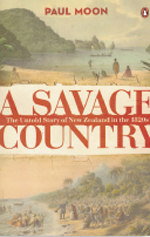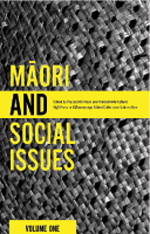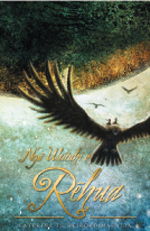Reviews
Oct 3, 2012

A SAVAGE COUNTRY: THE UNTOLD STORY OF NEW ZEALAND IN THE 1820s
Nā Paul Moon
Penguin Publishers
RRP: $39.99
Review nā Tom Bennion
Paul Moon is an entertaining writer and this book does not disappoint. I find this early period fascinating for the “what if” factor when relatively few people were making decisions that affected the future direction of the country. Had key players made different decisions, missed moments or had unexpected chance encounters, our history might have looked quite different.
The book covers missionaries, New South Wales officialdom, the modest flax investment “bubble”, whalers, sealers and of course the devastating musket wars. There is also mention of events about which we know frustratingly little, such as the Dusky Sound earthquakes of 1826–7 that produced a tsunami that possibly killed hundreds of Ngāti Mamoe.
However, enjoyable as it was, and despite the title, I did not discover much that was “untold”. Moon’s argument is that “comparatively little” is known about the 1820s. But his book is one of several in recent years focusing on the period. Angela Ballara’s Taua: “Musket Wars”, “Land Wars” or tikanga? and Dorothy Urlich-Cloher’s Hongi Hika: Warrior Chief being two important examples, although, surprisingly, neither appear in Moon’s bibliography. It also has to be said that the history and hard times of English missionaries in the decade are reasonably well discussed in a number of works.
A kind of thesis is outlined in the introduction, namely that the 1820s were an interregnum between the initial contact years and the beginning of colonisation. They were a moment when Māori confidently adopted European technologies but were affected by few if any of the cultural influences. That is a much less bold thesis than James Belich’s argument in Making Peoples that the period is one where the equation was “Europe multiplied by Māori agency” rather than a sum of “European agency plus Māori agency”. He wonders if the very high level of engagement with European technology and ideas in this period heightened the subsequent impact of colonisation as much as providing any kind of defence against it. It would have been interesting to see some engagement with theories of that nature.
Moon’s other thesis is that the 1820s was also a time when colonial officials in London began to take a second look at New Zealand. Consequently, the book perhaps suffers from advancing two modest theories about the period, combined with the limitations that come from choosing to focus on just one decade – a problem that Moon readily acknowledges. The result is an interesting retelling of events, presented under topics, and sometimes as a narrative; but overall giving few new insights on the period.
MĀORI AND SOCIAL ISSUES
Edited by Tracey McIntosh and Malcolm Mulholland
Huia Publishers
RRP: $45.00
Nā Gerry Coates
This book is planned to be the first in a series looking at what the publishers describe as “Māori research in areas that are critical for Māori and for broader society”. Expecting a dry read, I was pleasantly surprised at the depth of each chapter in both data and historical terms. The comprehensive topic areas include demography (a wealth of information here), education, parenting, mental health, obesity, smoking, poverty, child maltreatment, women and gambling, gangs, homelessness, incarceration, marginalisation and resilience.
Māori were estimated as numbering about 100,000 at the time of Cooks visit in 1769, but reached an historic low of 42,000 in 1896 that preoccupied bureaucrats and scholars with discourses about “fatal impact” until the early 20th Century, when a gradual recuperation began. While multi-generational households are the popular image of Māori, over three quarters live with only their parent(s), 41 per cent with a single parent. Yet it seems that “parent characteristics and the nature of the parent-child relationships were the best indicators of child outcomes”. Hence the importance of discussing parenting programmes to help Māori.
The corollary is child maltreatment, where Māori are over-represented both as victims and perpetrators. However, “these children only account for a small minority of the total population of Māori children, although they are made highly visible by the media”. A variety of approaches to prevent and intervene are suggested.
Māori gangs are another hot-button topic and a chapter looks at the rise of a gang culture with as many as 3500 members in a population of 4.3 million. Gangs as we know them began in the United States with newly discharged and unemployed soldiers congregating together. In Aotearoa, Māori gangs’ roots may reflect the “hopeless alienation” of a colonised past. This book provides the information to provoke better understanding of the risks and opportunities for Māori social issues.
NGĀ WAITUHI O RĒHUA
Nā Katerina Te Heikōkō Matira
Nā Huia Publishers i tā
RRP: $35.00
Review nā Charisma Rangipunga
Ka huakina te mata o tētahi pukapuka hōu. Ka whakaaro ake, “ka maroke rānei tēnei pukapuka? Ka eke rānei ia ki ngā taumata o whakahihiko i te hinengaro.” Ka ngā ki roto ka tīmata te pānui. Kāore e roa ka mōhio rānei koe mēnā kua mau koe me he ika i te matau o te aho, mēnā kua puta rānei koe i te koretake o te mounu. Ki te mau koe ki tautaia matau rā e mohio pū ana koe he toki te kaihī ika.
Ko te pukapuka “Ngā Waituhi o Rēhua” (nā Kahurangi Katerina Te Heikoko Mataira) he mea tuku i te hinengaro kia rere, kia whakaaro ake ka pēhea hoki te ao Māori inā ka mate, inā ka raru nui te ao e noho nei tātou, a Papatuanuku. Ki te hūnuku te iwi Māori ki ao kē noho ai. Ka pēhea te āhua o tā tātou noho ki kona? He aha hoki te āhua o te ao hōu? Ka pēhea hoki ō tātou tikanga, ō tātou kawa i te whenua hōu rā?
Ko Rēhua tērā, te ao hōu o te Māori. He noho moutere te āhua o te noho i runga anō i te kore tareka o te iwi Māori te whakawhiti i te moana pokopoko o te ao hōu rā. He aha hoki ai? He tipua kai tangata e noho ana i ngā rētōtanga o te wai. Mō te tokowhā rangatahi o te iwi rā, kua tipu ake te hiahia kia pōkai i ngā whenua, kia pōkai i ngā moana, kia whātorohia te ao me ōna āhuatanga mīharo katoa. Engari ka pēhea hoki? Māku e kī atu. I runga i te tuara o ngā manu tipua, ngā hōkio. Ka herea te tokowhā rā e ngā manu, ka whakawhiti atu i te moana kia tūtakitaki atu ai ki ngā iwi rerekē o tēnei te ao rerekē.
I roto i ngā whārangi ka kitea atu ā rātou mahi, te tipu o te tokowhā hei tangata me ērā āhua ka wero i te tangata tonu – te whāipoipo, te rapu i tō tūranga, i tō wāhi i te ao, te tipu, te patu i ērā kare ā roto ka pēhi i te tangata arā te pūhaehae, te harawene, te matapiko. Heoi ko te horopaki ko te ao hōu ka kore pea ka kitea e tātou me ōna iwi rerekē, ko te whawhai kia ora tō iwi, me te patu i ngā taniwha kai tangata. He mea whakahihiko i te hinengaro ka tika.
Ruarua noa iho ngā tāngata e tito pukapuka ana he pēnei te rahi, he pēnei te hōhonu o te whakaaro, e pēnei te pai te reo, he pēnei te whānui o ngā kaupapa. He uaua ka kite atu anō ai i tētahi e pērā ana i Te Heikoko. Ko tēnei pea te pukapuka mutunga ka puta atu i a ia i tana matenga, engari ka kite atu i roto ko tōna toa ko tōna maia hei kaituhi. Kāore pea i oti i a ia te wāhanga mutunga i te mea kei reira tonu a rau pātai e iri tonu ana. Heoi mā te aha i tērā? Ko tēnei o ngā kaihī ika, kāore e tua atu.
E tika ana me whakahīhī a Ngāi Tahu ki te pukapuka nei. Ko tātou anake te iwi Māori nō te ao tūturu ka whakaingoatia ki roto i ngā whārangi nei e Te Heikoko. He aha hoki te whakahonoretanga nui ake i tērā? Kaore kau pea. Ko tāku iti noa iho ko tēnei:
Ko Whārangi ka more
Ko Puka ka kiko kore
Taringa ka rahirahi kuri noa
Aroaroā ki āu kupu, ki tō reo.
E ngoi, e Te Heikoko, e taua e…
When one first opens the cover of a new book, the thought is always there: “Is this going to bore me to death, or is it going to excite me to the point where I can’t put it down?” A deep breath and the reading journey begins. It does not take long to find out whether you are caught like the fish on the end of a hook, or whether the bait is lacking. Should you find yourself caught, you know that the fisher is of undeniable talent.
This book Ngā Waituhi o Rēhua, by the late Dame Katerina Te Heikoko Mataira allows us to let our imaginations run wild and think of what the world might be like should the planet we live on no longer be available to us. Māoridom is forced to move to a new planet. How do we organise ourselves? What is this new planet like? How do our tikanga and kawa fare in this new land?
This is Rēhua, the new world of the Māori, who now find themselves living on an island, unable to cross the ocean surrounding it because of the man-eating leviathan living in its depths. For the four teenagers of this tribe, there burns an intense desire to explore the seas and distant lands, but how indeed to do this? Let me tell you. It can only be on the back of huge eagles. The four youths are taken by those birds and travel across the sea to meet others living in this strange world.
In the pages of this book you follow the adventures of the four, how they mature and those challenges that all of us face at some time or another – experiencing love, finding your place in the world, growing up, and how they deal with those things in life which test us like jealousy, malice, and disparity. They experience this in a setting foreign to us and with challenges we might never face, with peoples we will never meet, racing to save their race, and to destroy flesh-eating monsters that threaten their existence – exciting stuff indeed!
There are few people writing books of this size, with this level of thought, quality of Māori language, and variety of themes. We will be hard-pressed to find another to compare to Dame Katerina Te Heikoko Mataira. I was left feeling that the last section was somewhat incomplete, with many questions remaining unanswered. It is to no effect though. This fisherwoman is one of a kind.
It is only right that the chests of Ngāi Tahu puff out with pride at this book. We are the only tribe that Te Heikoko chooses to name as part of this story when referring to tribes of the old planet. How much greater honour can one be given? My humble response is to say…
The page will remain blank
And the book without substance
The ear forever listening never hearing
Left longing for your words, for your voice my dear, Te Heikoko…